You see, fresh, mature ginger root also contains an enzyme; gingerol (which converts to zingibain when cooked; for this reason, cooked or packaged ginger won't work here) – in fact, it’s another ingredient that will melt gelatin. However, in this case the protease enzyme reacts with the proteins in milk and changes them from a water-soluble protein to a non-water soluble one…allowing them to unwind and create that web-like network which holds water in a jiggly solid. It's not dissimilar to what happens when you make yogurt or cheese, except in those cases the enzymes are provided by bacteria, digestive juices, or both - the difference between this reaction and the gelatin reaction is in the type of protein molecule.
The key to this pudding is an exacting control of temperature; overcooking it will change the chemical composition of the gingerol and it won't work. Normally, when cooks need a constant temperature, they bring food to a boil: all boiling water (altitude permitting) stays at 212 degrees. Unfortunately for us, this particular enzyme reaction happens at about 150 degrees…a temperature best described as “really hot” without a thermometer – so an accurate instant-read thermometer is critical to the success of this project. (one recipe suggests heating the milk until bubbles “just form around the edge” but we’re going to rely on scientific tools.)
 How do you make sure your thermometer is accurate? Well, a good instant-read thermometer should read the same as your thermostat in your house with a small margin of error…but to make sure it’s really accurate, you can calibrate your thermometer like Sparky and I did: stick it in the center of a pot of boiling water (don’t touch the bottom or sides) and make sure it reads 212. Most thermometers have a little screw on the surface or a nut on the bottom so you can adjust the reading up or down if you find your thermometer is off more than a degree or so.
How do you make sure your thermometer is accurate? Well, a good instant-read thermometer should read the same as your thermostat in your house with a small margin of error…but to make sure it’s really accurate, you can calibrate your thermometer like Sparky and I did: stick it in the center of a pot of boiling water (don’t touch the bottom or sides) and make sure it reads 212. Most thermometers have a little screw on the surface or a nut on the bottom so you can adjust the reading up or down if you find your thermometer is off more than a degree or so.The pudding requires very few ingredients:
1 ginger root (NOT galangal or young ginger) about a 2 or 3 inch hefty knob
2 tablespoons of brown sugar (or other sweetener; brown sugar was my idea)
1 cup of milk (not ultra-pasteurized, so milk in sealed boxes probably won't work)
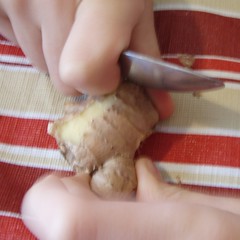 That's it! It's all in the chemistry - first, you extract the juice from the ginger: Remove the peel from the ginger by scraping it with a spoon.
That's it! It's all in the chemistry - first, you extract the juice from the ginger: Remove the peel from the ginger by scraping it with a spoon.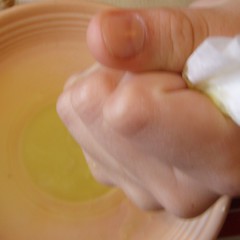 Grate the ginger (we had the best success using a microplane, although a regular grater works, too) into a paper coffee filter (knock all the pulp into the filter)
Grate the ginger (we had the best success using a microplane, although a regular grater works, too) into a paper coffee filter (knock all the pulp into the filter)Squeeze the coffee filter into a container to extract the juice. You will need about 2 teaspoons of ginger juice per cup of milk.
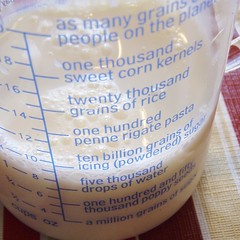 Next, heat your milk and sweetener (we used brown sugar, but other recipes suggest honey or plain sugar) in the microwave on high for one minute. Test the temperature with your thermometer…it needs to be between 140 and 170 degrees,
Next, heat your milk and sweetener (we used brown sugar, but other recipes suggest honey or plain sugar) in the microwave on high for one minute. Test the temperature with your thermometer…it needs to be between 140 and 170 degrees,  but it's preferable to get it somewhere right in between so that it doesn't cool below temperature while you are pouring. If it's too hot, just allow it to cool, if it's too cold, microwave in 15-second increments until you get what you want.
but it's preferable to get it somewhere right in between so that it doesn't cool below temperature while you are pouring. If it's too hot, just allow it to cool, if it's too cold, microwave in 15-second increments until you get what you want.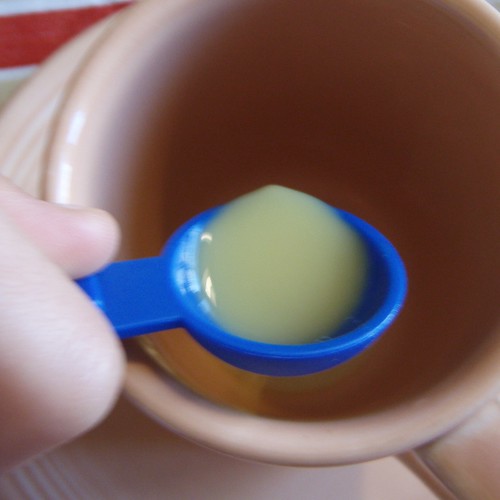 Measure the ginger juice into your serving containers – we're doing 1/2 cup servings, so 1 teaspoon of juice into each cup. Traditionally this pudding is steamed in a wok inside teacups and served warm, so teacups are a fine option. Dump in your hot milk all at once and DO NOT STIR. Don't be dainty, either - we dribbled the milk into the first cup because we were measuring carefully - wound up with an ugly ginger curd floating island.
Measure the ginger juice into your serving containers – we're doing 1/2 cup servings, so 1 teaspoon of juice into each cup. Traditionally this pudding is steamed in a wok inside teacups and served warm, so teacups are a fine option. Dump in your hot milk all at once and DO NOT STIR. Don't be dainty, either - we dribbled the milk into the first cup because we were measuring carefully - wound up with an ugly ginger curd floating island.Walk away and leave it alone for 3-10 minutes; you will know it is ready when it starts to pull away from the edges of the cup, and jiggles like gelatin.

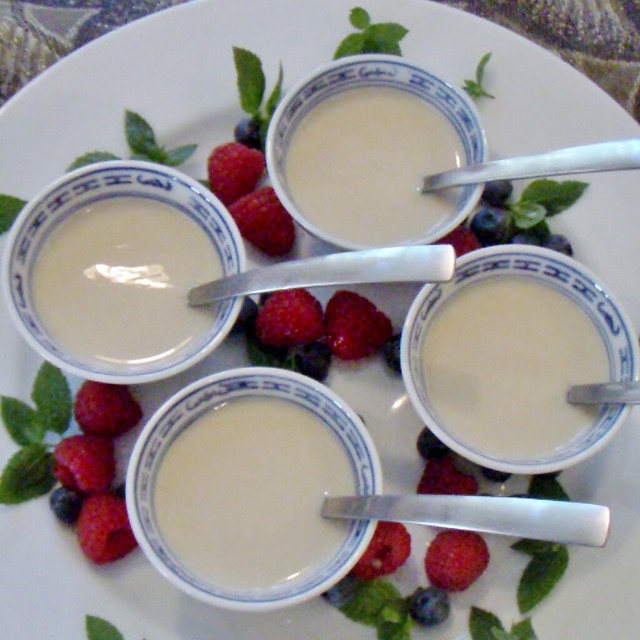





No comments:
Post a Comment